Andy Rubin
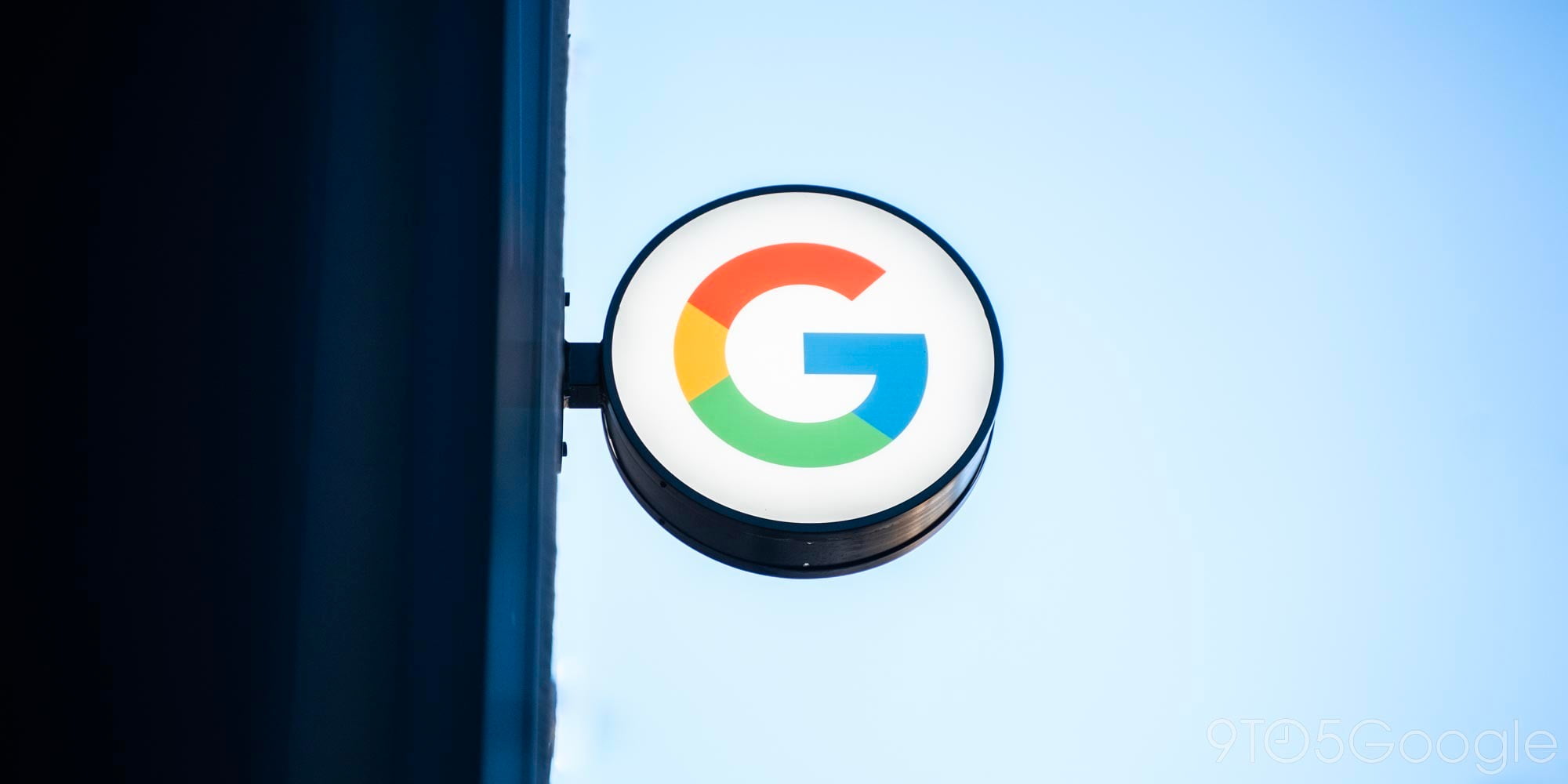

First they created self-driving (and maybe flying) cars. Then they created a new robotics division and put Android’s Andy Rubin in charge. And who could forget that they recently bought Boston Dynamics, the firm responsible for several DARPA-funded robotics projects?
Now, Re/code reports that Google is planning to purchase DeepMind, a London-based AI company that specializes in games and e-commerce algorithms. While Google could possibly put the company’s work on e-commerce to good use, Re/code indicates that Google is likely acquiring the firm for its talent, not so much for its technology. The site pegs the purchase price at round $400 million, but The Information says the number is actually closer to $500 million.
Just what does Google plan to do with all of these purchases? Some have previously speculated that the company is working on an intelligent delivery system to rival Amazon’s futuristic delivery drones. Andy Rubin has said that he has an interest in revolutionizing industries that have not yet been impacted by the precision of robotics technology, such as the assembly of electronics.
Or maybe they just want an army of terminators. But hey, who wouldn’t?

A pithy quote from a Google engineer working on Android on the day the iPhone was launched has been doing the rounds today.
As a consumer I was blown away. I wanted one immediately. But as a Google engineer, I thought ‘We’re going to have to start over.
The quote, attributed to Google engineer Chris DeSalvo, appears in Chapter 2 of Fred Vogelstein’s Dogfight: How Apple and Google went to war and started a revolution. It suggests that Google had to abandon a Blackberry-style smartphone in favor of a touchscreen one in direct response to the iPhone. This is seemingly supported by Android boss Andy Rubin reportedly saying in response to the webcast of the iPhone launch: “Holy crap, I guess we’re not going to ship that phone.”
There’s just one small problem with this version of events – it may not be entirely accurate … 
Expand
Expanding
Close

[youtube http://www.youtube.com/watch?v=tFrjrgBV8K0]
The New York Times reports that Google has just acquired Boston Dynamics, the robotics firm that created machines such as Petman (seen in the video above) and other mechanical terrors wonders that look as close to something out of the Terminator movies as we’ve seen yet.
https://twitter.com/arubin/status/411737161642168320
The buyout comes on the heels of the revelation that the company is planning a move into the robotics industry with Android co-creator Andy Rubin at the helm. Boston Dynamics’ resources and engineers will make an invaluable addition to Google’s growing collection of robotics experts.

Steve Jobs isn’t exactly a man known for keeping his thoughts to himself which is why excerpts found by Business Insider from a new book documenting the Google-Apple smartphone war are grabbing attention. According to the book written by Fred Vogelstein, Google was already working on its first Android-powered smartphone when Apple introduced the iPhone in 2007.

https://www.youtube.com/watch?v=TNOsB8tRmWU
Lost in the shuffle of today’s events is that Google TV is getting significant updates today.
Today, Google TV is moving to the latest version of Android (Jelly Bean, 4.2.2), and we’ve refactored Google TV so that our TV OEM partners can update to future versions of Android in a matter of weeks rather than months. For developers, this means you can build TV experiences using the latest Android APIs, including the NDK.
Today Google TV is also moving to the latest version of Chrome, and from now on Google TV benefits from Chrome updates on the same six week cycle that you’ve come to expect from Chrome. In Chrome on Google TV, we’ve added support for hardware-based content protection, enabling developers to provide premium TV content in HD within their web apps.
Google TV has always been a(t least a) generation behind Android phones and you have to wonder if Andy Rubin’s move away from Android is allowing the YouTube group that runs GoogleTV more access to core Android features. Word on the Street is that Rubin and YouTube boss “couldn’t be in the same room together”.
Speaking of YouTube, the GoogleTV Youtube App got a facelift today with the following additions:
– New home screen interface.
– Enhanced video playback controls.
– Support for paid subscriptions.
Update: LG is on board. Press release and 4.2.2 demo below
Expand
Expanding
Close

 We heard in October that Google had plans to further reduce Motorola’s workforce after cutting around 20 percent, or roughly 4,000 jobs, in August. The Wall Street Journal reported today on an email from Google that confirmed the company is beginning to cut around 1,200 employees (a little over 10 percent of its current total headcount):
We heard in October that Google had plans to further reduce Motorola’s workforce after cutting around 20 percent, or roughly 4,000 jobs, in August. The Wall Street Journal reported today on an email from Google that confirmed the company is beginning to cut around 1,200 employees (a little over 10 percent of its current total headcount):
Motorola MSI -0.74% staffers were informed by the company via email this week that “while we’re very optimistic about the new products in our pipeline, we still face challenges.” The company email added that “our costs are too high, we’re operating in markets where we’re not competitive and we’re losing money.”
As for where the cuts might take place, we previously reported that Motorola, which was unprofitable for 14 of its last 16 quarters, planned to reduce its operations in Asia and India, but today’s report said the layoffs would hit workers in the United States, China, and India. Google also warned that further restructuring might be necessary and significant costs could be involved.
In a recent piece from The Wall Street Journal highlighting Google executives’ fear that Samsung is gaining too much dominance, Android chief Andy Rubin said the purchase of Motorola was “a kind of insurance policy against a manufacturer such as Samsung gaining too much power over Android.”

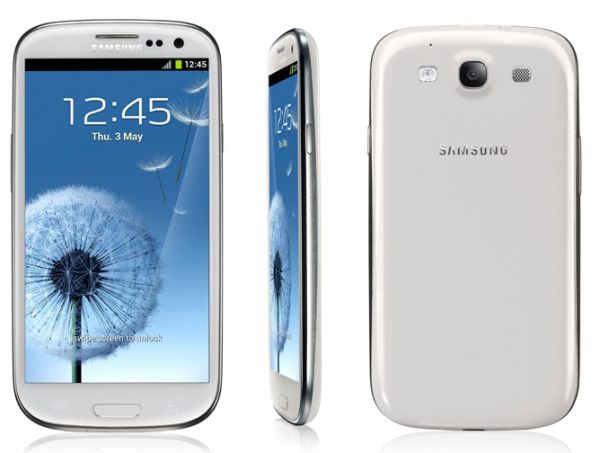 While Google might be happy with the mobile ad revenue Samsung brings in shipping roughly 40 percent of the devices running Android, The Wall Street Journal said Google execs worry behind closed doors that Samsung could use its dominance to renegotiate its cut of revenue from mobile ads and search:
While Google might be happy with the mobile ad revenue Samsung brings in shipping roughly 40 percent of the devices running Android, The Wall Street Journal said Google execs worry behind closed doors that Samsung could use its dominance to renegotiate its cut of revenue from mobile ads and search:
Google executives worry that Samsung has become so big—the South Korean company sells about 40% of the gadgets that use Google’s Android software—that it could flex its muscle to renegotiate their arrangement and eat into Google’s lucrative mobile-ad business, people familiar with the matter said.
Citing its usual “people familiar with the matter,” WSJ claimed executives at Google are betting on companies like HTC and HP to release compelling Android devices that compete with Samsung. According to the report, Android chief Andy Rubin discussed the situation at a recent event for Google executives. He described Motorola as “a kind of insurance policy against a manufacturer such as Samsung gaining too much power over Android.”
Expand
Expanding
Close

Are you ready for the latest breakdown of Android’s performance ahead of Apple’s iPhone 5 event tomorrow afternoon? Android boss Andy Rubin just announced this evening that 500 million Android devices have been activated to date, which follows Eric Schmidt’s announcement of 480,000 devices last week. Rubin reiterated Schmidt’s announcement, claiming 1.3 million Android devices are being activated daily (70,000 of which are tablets). Last week, we calculated Google could hit a whopping 1 billion devices activated in a year’s time at its current growth. Tonight’s announcement was definitely interesting timing.
[tweet https://twitter.com/Arubin/status/245663570812100608]

[tweet https://twitter.com/timbray/status/205359972647829504]
A jury decided this morning that Google did not infringe upon Oracle’s patents.
The verdict came unanimously as jurors in the Google vs. Oracle trial found six claims in U.S. Patent RE38,104, including two claims in U.S. Patent number 6,061,520, did not infringe.
“Today’s jury verdict that Android does not infringe Oracle’s patents was a victory not just for Google but the entire Android ecosystem,” announced Google in a public statement, according to CNET.
Oh, and here is Oracle’s public statement on the decision: “Oracle presented overwhelming evidence at trial that Google knew it would fragment and damage Java. We plan to continue to defend and uphold Java’s core write once run anywhere principle and ensure it is protected for the nine million Java developers and the community that depend on Java compatibility.”

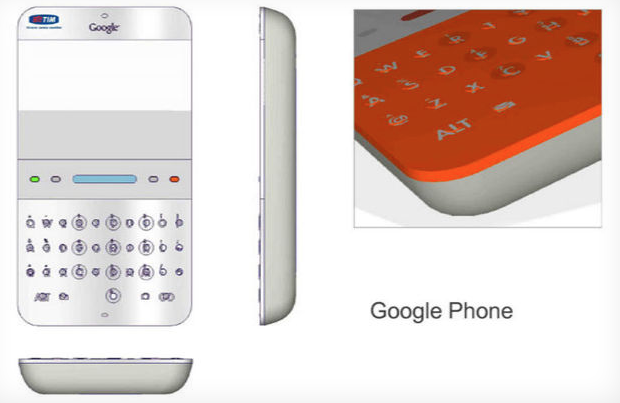
There is a lot of interesting news coming out of the Google v. Oracle Java trial today. Yesterday, former CEO Eric Schmidt gave his testimony to the court, and today Andy Rubin took the stand where he revealed a slide deck with Google’s ambitions to sell 10 million Android tablets during 2011 and other pieces of information related to Android revenue.
On-hand reports from The Verge point us to a few of the more intriguing statements made by Rubin and others today:
Google Phone:
The image above is of the “original Google phone” concept presented to carriers almost two years before Google finally launched the first Android handset, the T-Mobile G1. The images of the device came up in the trial due to references to Java in the designs. A year later, in May 2007, almost a year after iPhone, Google was still designing Android with a physical keyboard in mind—as noted in Android specification documents during the trial.
Android Revenue:
First, we get a close look at Android revenue numbers for the first time. The numbers come from a quarterly report given by Rubin and others in 2010 that show the company expected revenue from Android to reach $278.1 million during the year.
The forecast was based on increasing the roughly 20 million Android phones in the market at the time to 40 million by the end of the year. Google was also expecting to pull in $158.9 million in Android ad revenue and just $3.8 million from its 30 percent cut of app sales. According to the report, Google forecasted bringing in $840.2 million from Android ads and $35.9m from app sales in 2012.
Subsidized unlimited data plans:
Another interesting document that emerged from the trial shows Google suggested to T-Mobile in 2006 that it would give up its finder’s fee commission for new customers in order to provide Android phones with $10 monthly unlimited data plans. Of course, that plan was never carried out, and the original Android T-Mobile G1 launched with the conventional $25+ plans.

The ongoing Oracle v. Google trial is churning up some doozies regarding the history of Android, and this latest one is almost unbelievable: Google projected to sell roughly 10 million Android tablets a year for 2011 and 2012 while seizing a third of the marketshare.
A presentation by former Android Inc. CEO Andy Rubin in July 2010, exhibited during the trial, revealed those hefty figures. Obviously, Google’s view was a little optimistic, especially because the search engine also expected Android tablets to reap $110 million in search revenue for 2011 and $220 million for 2012.
The company’s ballpark figures derived from a then-current Morgan Stanley estimate that placed the tablet market around 46 million units for 2012. Needless to say, Google missed its target. Rubin admitted last February that only 12 million Android tablets sold in the previous two years. Apple, on the other hand, has a stronghold on the market with over 67 million iPads sold, of which 11.8 million moved in Q2 2012 alone.
Today’s two-year-old slide deck is significant, because it unearthed the first-ever Android revenue numbers, as well as early user-interface designs for Android 3.0 Honeycomb.
The gallery of slides is below.

Android smartphones are definitely putting on a great show. As the total number of Android devices around the world jets past 300 million and 850,000 devices get activated each day, nobody in their right mind would argue that Android has become the most powerful platform. It exceeded an estimated 50 percent of the market for smartphones both globally and in the United States. The same cannot be said for Android tablets. Whilst Android-driven slates saw a much-needed uptick since the arrival of tablet-optimized Android 4.0 Ice Cream Sandwich software, Apple’s iPad still dominates the once niche and now rising market segment.
Google is well aware of its shortcomings in the tablet arena and the company is ready to “double down on tablets,” according to its mobile head Andy Rubin. He told The Verge that in two years some 12 million Android tablets were sold—the figure he called “not insignificant, but less than I’d expect it to be if you really want to win.” He is hoping that “2012 is going to be the year that we double down and make sure we’re winning in that space.” Acknowledging the overall lack of high-quality apps is an issue resulting in many prospective buyers considering Apple’s iPad, Rubin urged developers to “put in the muscle and make their apps work great on tablets.”
By the way, we wonder if by “doubling down” Rubin meant a self-branded 7-inch Ice Cream Sandwich tablet said to arrive by summer with a $199 price tag. Also, it was not immediately clear from the report whether the 12 million figure includes the millions of Fire tablets Amazon sold thus far (likely not, as that device runs forked Android software), but clearly Samsung has done a lot here to help push Android slates.

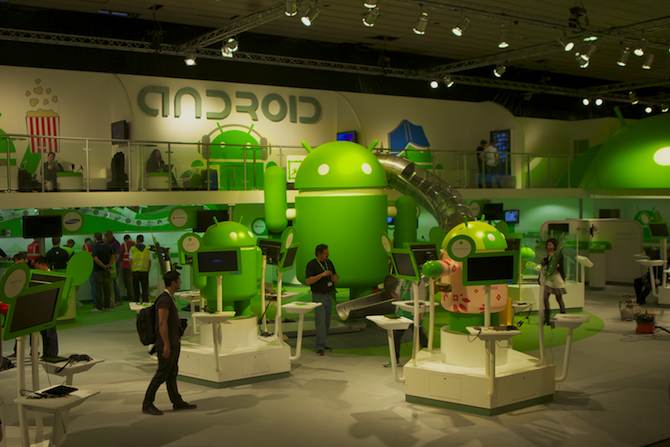
Google has a dominant presence at the Mobile World Congress (MWC) show now underway in Barcelona, Spain from Feb. 27 through March 1. The company’s Andy Rubin, senior vice president of mobile and digital content, shared a few updates related to the Android ecosystem, and he revealed in a blog post that 850,000 Android devices are now activated each day with the total number of Android devices around the world past 300 million.
The number of apps available in Android Market tripled from 150,000 at the last year’s show to 450,000 items today. Moreover, the Market is now recognizing over a billion downloads each month. All told, about 800 different Android devices launched to date and the company is highlighting more than a hundred new ones at its huge stand at MWC…

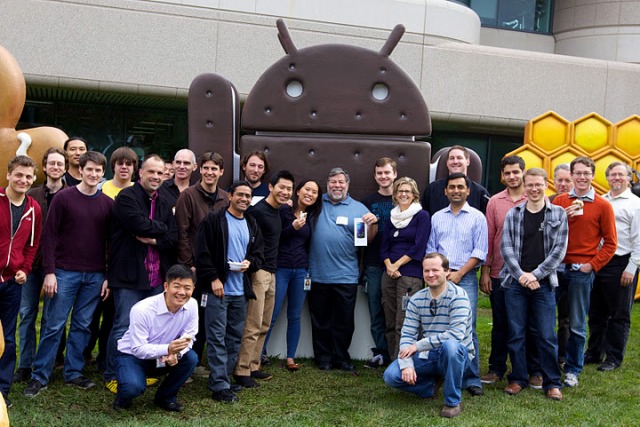
UPDATE [Wednesday, January 18, 2012 at 7:35am ET]: Steve Wozniak commented on the original article on Facebook, saying he’s been misinterpreted (again). His full comment can be found at the bottom of this article.
Apple cofounder Steve Wozniak never shied away from admitting that he uses Android phones on a daily basis —in addition to his iPhone. The famous geek even received the Galaxy Nexus before the rest of the United States (although he likes the Motorola Droid Razr better). Given that Wozniak, a vocal critic of today’s smartphone design, has been misquoted in the past, you may want to take this one with a few pinches of salt. According to reporter Dan Lyons’s story published by The Daily Beast, Woz said Android beats Apple’s iPhone:
My primary phone is the iPhone. I love the beauty of it. But I wish it did all the things my Android does, I really do. […] If you’re willing to do the work to understand it a little bit, well I hate to say it, but there’s more available in some ways.
The Woz is a long-time friend of Andy Rubin, the head of the Android project and former board member of Danger, Rubin’s previous startup behind the Sidekick smartphone…

In a clearing up the “confusion” around Andy Rubin’s recent numbers releases (here and here), the Verge spoke to a Google source on what constitutes an “Android device activation.”
We’ve now gotten some additional clarification from trusted sources on what Google considers an “Android device” for the purposes of counting activations (which would presumably apply to every activation count Google has released in the past). It’s actually really simple: you need to activate Google services on the device. In all likelihood, Google’s counter actually jumps the moment you sign into your Google account on the phone or tablet, whether that be the first time you turn it on or when you’re prompted after jumping into something like Gmail or the Android Market. And as Rubin says on Google+, it only happens once per physical device.
It turns out that Google is only counting activations it activates (I know!). It is not counting devices that use Android code, because it does not have control over -or no way of- counting like the Kindle Fire or Barnes and Noble Nook (I know!).
Perhaps Amazon, who is very transparent with its Kindle numbers, could help Google out there.

Title says it all. Andy Rubin just tweeted some more Android numbers and they are pretty impressive. In the two day Christmas period, 3.7 million Android phones were activated. Compare that to 1.4 million on an average two day period.
Another comparison: After 16 months without releasing a phone, Apple sold 4 million iPhone 4S’s in the first week of release.
The Android Freight Train continues to roar.
Expand
Expanding
Close

Rubin made the announcement through Google Plus (and Twitter) and noted:
…and for those wondering, we count each device only once (ie, we don’t count re-sold devices), and “activations” means you go into a store, buy a device, put it on the network by subscribing to a wireless service.
Google’s latest public figure was just 550,000 devices a day that was noted by Chairman Eric Schmidt in Germany earlier this year and confirmed a few times, most recently at LeWeb last week.
To put it in perspective, 700,000 devices a day is almost 5 million every week, or 21 million a month, or over a mind-boggling 250 million a year.
As a comparison, Apple announced 1 million iPhone 4S’s sold in the first day of sales and topped 4 million in the first week (after some pent up demand and a week of preorders).
The Freight Train continues to roar.
Expand
Expanding
Close

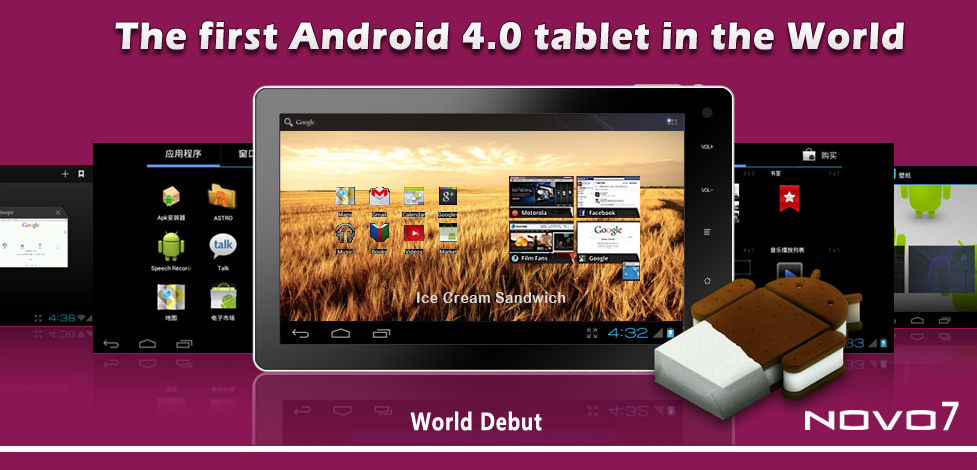
There is no shortage of cheap Android tablets from Chinese manufacturers that can be found for under $200 online, most of which are running an older version of Android and don’t have Google’s blessing (meaning no Google services and Market). MIPS Technologies and Ingenic Semiconductor announced today availability of the world’s first Ice Cream Sandwich, Android 4.0-powered tablet, and it just so happens to a $99 budget-friendly tab with decent specs.
The tablet will pack in a 1GHz MIPS-based ‘XBurst” CPU, 7-inch capacitive touchscreen, microSD, HDMI 1.3, WiFi 802.11 b/g/n, USB 2.0, 2-megapixel main cam, front-facing cam, and bluetooth. Ainovo, the company offering up the tablet to the Chinese market, is promising 30 hours standby and 8 hours video playback for battery.
The Novo7 will become available to the US market (likely with different branding) through other companies including OMG Electronics Ltd. and Leader International Inc. at a later date. There will also be 8 and 9-inch variants released in the future, mostly likely depending on the success of the 7-inch model. You might have to pay a little more than the US $99 price tag to get it shipped from a Chinese supplier before it lands stateside, but it will probably be your first chance to get your hands on an ICS tablet if you do.
Google’s Andy Rubin had this to say about the launch of new MIPS-based ICS tablets like the Novo7:
Expand
Expanding
Close

From 9to5toys.com:
Woot! via Amazon has the 32GB Motorola XOOM Android Tablet for $339.99. That’s 32% off and the lowest price we could find for this refurbished item.
Andy Rubin told the audience at AllThingsD in Asia that the XOOM would be the first tablet to be upgraded to Ice Cream Sandwich later this year.
Expand
Expanding
Close

![]()
According to an SEC filing made by Motorola today (seen after the break), Motorola was able to get $3 billion more out of Google before they were acquired for $12 billion — even without any other bidders present. But it isn’t that simple.
Today’s report contradicts August’s, saying Andy Rubin actually assisted in the acquisition when he reached out to Motorola first. It was previously stated that Rubin has no knowledge of the acquisition until the buyout was close to being announced. Rubin and company reached out to Motorola to buy patents, after losing the Nortel deal according to the filing.
The story continues as follows: Motorola’s Sanjay Jha told Google that Motorola wouldn’t only sell patents, rather the whole Motorola Mobility sector. Motorola than rejected two of Google’s offers which were $30 and $37 a share respectively, until both companies finally settled on a final price of $40 per share. Google, it appears, was in a hurry to get the deal done and bid pretty close to Motorola was after in order to avoid going to a long, drawn out auction process.
SEC filing after the break:


Image courtsy of Anandtech
TIMN reports that Google’s head of mobile, Andy Rubin, dropped a bombshell during his on-stage appearance at the Intel Developer Forum, by announcing that all future versions of Android will be optimized for Intel chips top to bottom. Intel also showed off a prototype Android tablet and phone running on the Medfield chip. Medfield is Intel’s fourth-generation mobile Internet device platform based on a 32-nanometer Atom processor.
The news prompted former Engadget editor Joshua Topolsky to observe on Twitter that Google is cozying up to Intel’s x86 platform at a time when Microsoft is adding support – for the first time in its history – for ARM’s mobile platform in Windows 8. Of course, we remember that Intel promised on numerous occasions that we’d see phones running on Intel chips in “early 2012,” even if everyone assumed the company was referring to Windows 8-powered devices. Google here wants to cover all bases with future versions of Android and it’s likely that the announcement will spark more competition between Intel and chip vendors that manufacture mobile chips based on ARM’s processor blueprints.

The smoke has cleared on Google’s $12.5B purchase of Chicago-based Motorola and now that almost everyone has had a chance to speak, I think we’re starting to understand what went down.
Google purchased Motorola (MMI) for $12.5B, a 63% premium over its weekend closing price. Motorola, however, has around $3B in cash and securities, which makes the real purchase a slightly more reasonable $9.5B for Google. For instance, if Google wanted to slice and dice Motorola, they’d take the cash and patents and sell off the cable box and device divisions for a couple billion dollars each and come away with about what they would have paid for Nortel – and get double to triple the patents. On sheer numbers of patents alone, it seems like a good buy. Obviously some patents are worth more than others.
If the deal doesn’t go through, Google owes Motorola $2.5B for the trouble, so Google is dead serious about this play.
But back to what Motorola does: They have IP, they make smartphones, they make tablets and they make cable top boxes. It seems like almost too good a setup for Andy Rubin’s Android to just want to sell off piecemeal.
But did Google want to pick up a hardware company? I reported earlier this year that the Android Hardware division that Andy Rubin had started up with former Danger Co-founders had intentions to build physical devices, not just Operating Systems.
That scale is what attracted and the former Danger founders to get the band back together, with their goal being to build the hardware and features they want to see show up in new Android devices. It’s not enough for Google to just provide Android software to carrier — now they hope to influence what handset makers build, too.

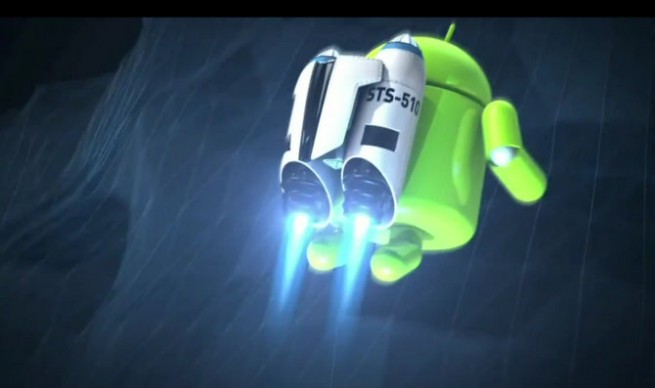
This little factoid came an hour ago straight from the Android chief Andy Rubin, who tweeted:
There are now over 500,000 Android devices activated every day, and it’s growing at 4.4% w/w.
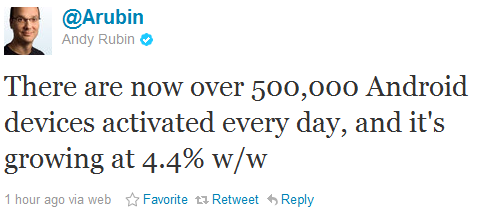
Compare that to some 210,000 daily activations for Apple stemming from the 19 million iPhones they sold in the last quarter. Google’s data point is a notable improvement over the 400,000 daily activations Google’s mobile chief Rubin reported last month at the Google I/O conference. Where are 100,000 additional devices being activated each day? Maybe China? Mobile handset base there grew to 910 million in May, a 1.08 percent and 14.35 percent sequential and annual increase, respectively. Many Android phones in China sell for less than $150, vendors like Arima Communications are promising sub-$100 handsets this summer and then there are really cheap Android knock-offs from white-label vendors.

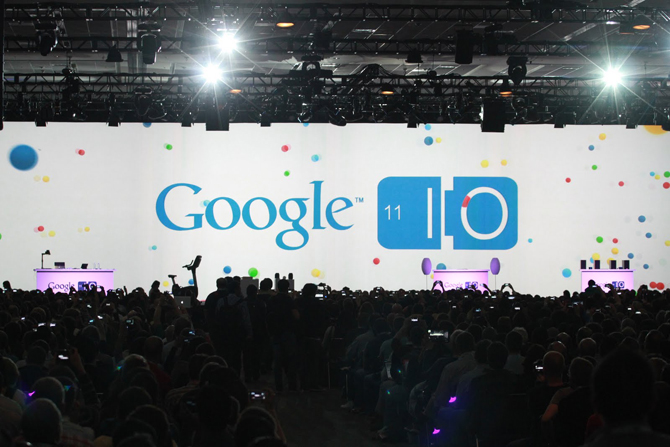
A lot of interesting news came up during yesterday’s Android-focused keynote. We’ve processed key announcements for you, but there’s a whole bunch of tidbits and nice-to-knows that came in yesterday’s keynote. As we await Chrome OS-related Day Two Keynote, why not watch the entire video footage from yesterday? It’s embedded below the fold or available over at YouTube.
The hour long presentation includes a bunch of Google engineers giving cool on-stage demos, in addition to key executives like the Android head Andy Rubin and vice president of software engineering Vic Gundotra. Hint: Scrub to mark 2:10 for an amusing anti-Apple moment. You can also rewatch the Google I/O 2011 countdown, in case you missed it. Google will provide real-time video stream of Day Two Keynote, which is scheduled for Wednesday, May 11, at 9:30am Pacific time.
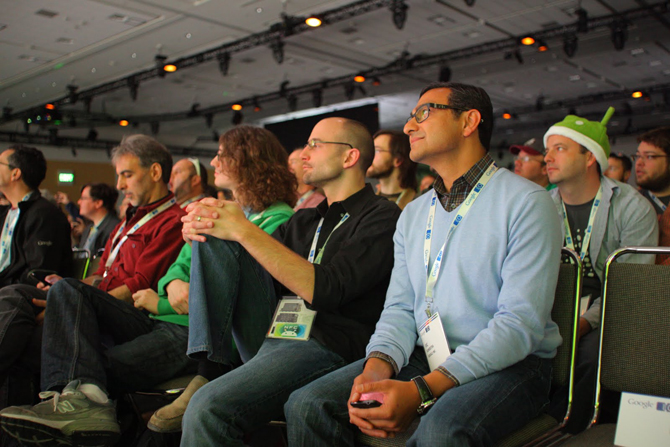
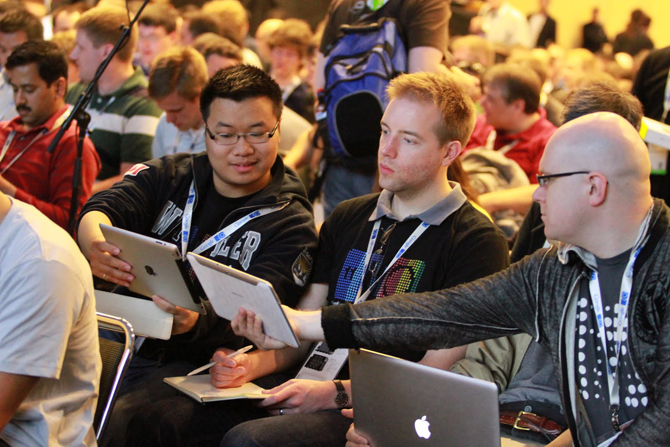
(Left) Software engineering head Vic Gundotra sits in the front row as his colleagues demo new Android features (Right) Audience members comparing their slates